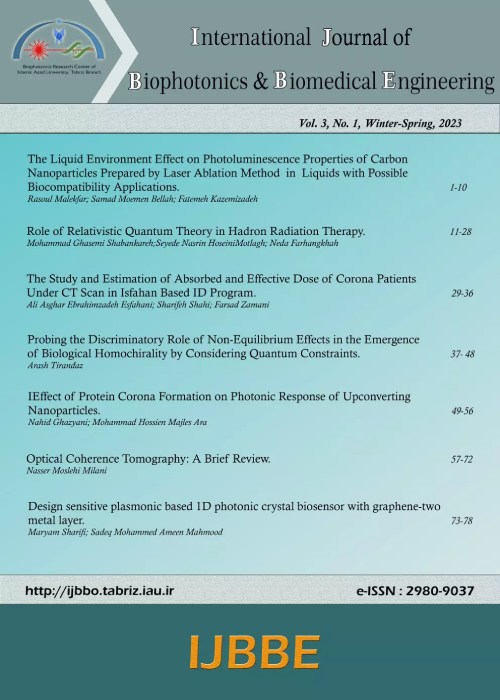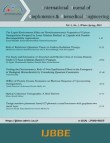فهرست مطالب

International Journal of Biophotonics and Biomedical Optics
Volume:3 Issue: 1, Winter and Spring 2023
- تاریخ انتشار: 1402/04/10
- تعداد عناوین: 7
-
Pages 1-10Fluorescent carbon nanoparticles (CNPs) were prepared by nanosecond laser ablation of graphite powder in liquid. The effect of the liquid medium on photoluminescence (PL) efficiency and wavelength range were studied experimentally. Four solvents, polyethylene glycol, diethanolamine, diethylamine, and ethylenediamine were used as liquid platforms in the synthesis process. Analyzing the chemical components and optical spectral characterization of CNPs was carried out by attenuated total reflection Fourier-transform infrared (ATR-FTIR) spectroscopy and photoluminescence (PL) spectroscopy, respectively. Moreover, the size of CNPs was estimated by using dynamic light scattering (DLS) measurements. Liquid components are determined to be a key factor affecting PL properties and nanoparticle size. The results are valuable in practical applications.Keywords: carbon nanoparticle, fluorescent, laser ablation in liquids, Photoluminescence, Biocompatibility
-
Pages 11-28In recent years, the attention of scientists has been drawn to laser accelerators because they have a smaller size and more power than RT accelerators. But to upgrade these laser accelerators for hadron therapy, the theory governing these accelerators needs more investigation. The present paper represents the theory of laser-driven accelerators. Also, for the first time, we calculated the quantum relativistic important parameters such as the effective atomic number, z_eff, β=v⁄c , parameter, the density effect, δ⁄2, the shell effect,〖∆L〗_shell, Barkas effect, L_Barkas , Lynard Sorensen, effect, 〖∆L〗_LS, the standard perturbation function, L_stand, the first order general term of quantum perturbation theory, L_Pert, for proton and carbon beams in different energies versus the depth of penetration in the different human tissues using Maple programming, and our numerical results show that since the physical and chemical properties of carbon and hydrogen ions are not the same and carbon is heavier than hydrogen, carbon and hydrogen ion beams in hadron therapy do not have the same behavior inside the different human tissues.Keywords: carbon, proton, Laser, relativistic, Tissues, Quantum
-
Pages 29-36Since the emergence of the coronavirus and the international community's attention to this virus, researchers and medical staff in hospitals have put approaches and methods for dealing with it and early diagnosis on their agenda. In this study, one of the method that called the Impact Dose program has been presented to calculate the absorbed and effective dose of people infected with the Covid-19 virus using CT scans of the respiratory tract. This is an analytical cross-sectional study that was conducted at Isfahan Shariati Hospital. The study is included of the 42 patients with Covid-19, who were selected based on doctor's opinion. The effective and absorbed dose were estimated by using the Impact Dose program, which is based on Monte Carlo. The data were analyzed using SPSS-24 software. The effective dose and DLP were reported as 1.67 mSv and 80.08 mGy.cm, respectively. The absorbed dose and effective dose were found to be higher in women than in men. The multiple CT scans of patients for the diagnosis of Covid-19 resulted in a very high absorbed dose, and lung sonography was recommended as an alternative method due to its high accuracy, similar to CT scans, in diagnosing pneumonia.Keywords: absorbed dose, Effective dose, COVID-19, Lung CT, Impact dose, Monte Carlo
-
Pages 37-48Emergence of biological homochirality is an everlasting mystery in the history of interdisciplinary researches. In this work, the discriminatory role of non-equilibrium effects in the emergence of chiral configurations of biological conformers is discussed. Based on the theory of open quantum system a Born-Markov master equation is derived for the analysis of chiral weights when the chiral molecule interacts with two environments at different temperatures, simultaneously. It is shown that interaction of a chiral molecule with non-equilibrium environments, results in discrimination of specific handedness for both of possible configuration that depends on characteristics of the environments. Real chiral chromophores for which experimental results are available, have been examined under the proposed theoretical framework.Keywords: handedness, Born Markov approximation, Master Equation, Spectral densities, Stabilization of Handedness
-
Pages 49-56
NaYF4:Yb,Er is one of the efficient and well-known upconverting materials which emit photoluminescence light at 545 nm and 660 nm under an excitation of 980 nm. In this study, up-conversion nanoparticles using thermal decomposition method have been synthesized and characterized and phase transition from organic to aquas by synthesis a SiO2 shell have done successfully. The results show that the nonlinearity response of NaYF4: Yb, Er@SiO2 is same as NaYF4: Yb, Er and SiO2 has no effect on emission peaks it means that these nanoparticles are suitable for biomedical applications. Since it is necessary to know the photoluminescent behavior of UCNPs@SiO2 particles, thereby the fluorescence properties of up-conversion nanoparticles with SiO2 shell have been investigated in PBS, normal and cancerous human blood plasma. The results indicate that UCNP@SiO2 can be applicable in biological medias for therapy and diagnostic.
Keywords: Nonlinear photoresponse, Upconversion Nanoparticles, Protein Corona, Corona Formation, human blood plasma, near infrared -
Pages 57-72
Optical coherence tomography (OCT) is a new imaging technique with a significant role in the field of medicine. It is a light-based non-invasive imaging method that provides high quality cross-sectional and volumetric images. OCT technology was introduced in the early 1990s and advanced to produce quicker obtaining times and higher resolution. In this article we discuss some of the recent advancements in OCT imaging systems. We will review a brief history and first operating principles including light coherence interferometry (LCI), time domain optical coherence tomography (TD-OCT) and Fourier domain optical coherence tomography (FD-OCT) contains two types: spectral domain optical coherence tomography (SD-OCT) and swept source optical coherence tomography (SS-OCT). Also we review recent emerging innovative OCT systems including Doppler OCT, polarization sensitive optical coherence tomography (PS-OCT), high resolution optical coherence tomography (HR-OCT), full field optical coherence tomography (FF-OCT), wide field optical coherence tomography (WF-OCT), optical coherence elastography (OCE), adaptive optics optical coherence tomography (AO-OCT), visible light optical coherence tomography (Vis-OCT), intraoperative optical coherence tomography (iOCT), hand-held optical coherence tomography (HH-OCT), and OCT in needle format.
Keywords: cross-sectional imaging, low coherence interferometry, superluminescent light emitting diodes, ocular imaging, optical coherence microscopy -
Pages 73-78In the present paper , we propose surface plasmon resonance biosensor in combination with a photonic crystal that works based on changing the refractive index of the biomaterial using the transfer matrix method to diagnose blood components. The proposed biosensor structure is (TiO2/ SiO2)^2 / silver/ gold/ graphene , which gives a narrow angular reflectivity resonance. The performance parameters of biosensor such as sensitivity, detection accuracy reported. Our results show that the sensitivity of the proposed configuration is 150 deg /RIU, which is acceptable compared to the values reported in previous studies and shows better performance of the proposed biosensor.Keywords: Biosensor, Graphene, Photonic Crystal, Surface plasmon resonance, Sensitivity


